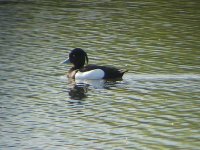George Edwards
Nom de plume
Hi, more than likely these questions are answered elsewhere. Apologies if they are I haven't read all the posts but I couldn't find anything basic enough in the titles. Just skip this thread if I'm the 100th newbie to ask the same questions!
I know absolutely nothing about birds and scopes! Though I'm hoping to learn. (I'm still waiting for my first bird book (Collins) from Amazon). I know a fair amount about traditional SLR photography.
As I understand it, digiscoping is using a digital camera (probably with or without the camera's own lens, and using an adapter) to take pictures though a scope. Tripods are presumably necessary for all long lenses, with or without cameras.
My questions are:
1. What is a scope (I know it's a telephoto lens of some sort)?
Is it the modern name for telescopes?
What is the difference between "birding scopes" and other scopes? Is it minimum focusing distance or brightness?
2. What is the advantage of taking a picture using a scope over just using a ready-made telephoto lens?
Is it because birders already have scopes which they can now use with cameras (thus saving the cost (and weight) of an expensive lens specially for the camera)?
Is it because scopes are better in some way or cheaper than similar power telephoto camera lenses? Or more powerful perhaps?
Is it because scopes are dual-use - you can just go out with your scope if you don't feel like taking pictures? Also you're not committing yourself to one camera system - you can use your scope in ten years time, whereas expensive camera systems have a horrible tendency for going out of date?
Is looking through a scope nicer in some way than looking through a camera viewfinder/back? (Wider field of vision, brighter, more comfortable? Lighter in weight for sure). I'm assuming scopes don't have digital viewfinders.
3. What is the advantage of a scope over binoculars?
Is it just you can't digiscope with binoculars?
I'm guessing digiscopes are more powerful? From what I've seen binoculars are normally 10 to 15 times magnification, and vary in width of view. (My borrowed ones are 9x20. I find it very difficult to locate a bird I can just see with the naked eye, on a tree in front of me! But that's because of the restricted field of vision.)
Is autofocus involved?
Weight per image magnification must be better with scopes as there's only one lens instead of two, I imagine.
Well, if you've come this far, thanks for bearing with me, and I'd be really grateful for any answers or links. I realise many people who use this site are pro or near-pro in birding or photography, so just skip this post if it's too basic. TTFN!
I know absolutely nothing about birds and scopes! Though I'm hoping to learn. (I'm still waiting for my first bird book (Collins) from Amazon). I know a fair amount about traditional SLR photography.
As I understand it, digiscoping is using a digital camera (probably with or without the camera's own lens, and using an adapter) to take pictures though a scope. Tripods are presumably necessary for all long lenses, with or without cameras.
My questions are:
1. What is a scope (I know it's a telephoto lens of some sort)?
Is it the modern name for telescopes?
What is the difference between "birding scopes" and other scopes? Is it minimum focusing distance or brightness?
2. What is the advantage of taking a picture using a scope over just using a ready-made telephoto lens?
Is it because birders already have scopes which they can now use with cameras (thus saving the cost (and weight) of an expensive lens specially for the camera)?
Is it because scopes are better in some way or cheaper than similar power telephoto camera lenses? Or more powerful perhaps?
Is it because scopes are dual-use - you can just go out with your scope if you don't feel like taking pictures? Also you're not committing yourself to one camera system - you can use your scope in ten years time, whereas expensive camera systems have a horrible tendency for going out of date?
Is looking through a scope nicer in some way than looking through a camera viewfinder/back? (Wider field of vision, brighter, more comfortable? Lighter in weight for sure). I'm assuming scopes don't have digital viewfinders.
3. What is the advantage of a scope over binoculars?
Is it just you can't digiscope with binoculars?
I'm guessing digiscopes are more powerful? From what I've seen binoculars are normally 10 to 15 times magnification, and vary in width of view. (My borrowed ones are 9x20. I find it very difficult to locate a bird I can just see with the naked eye, on a tree in front of me! But that's because of the restricted field of vision.)
Is autofocus involved?
Weight per image magnification must be better with scopes as there's only one lens instead of two, I imagine.
Well, if you've come this far, thanks for bearing with me, and I'd be really grateful for any answers or links. I realise many people who use this site are pro or near-pro in birding or photography, so just skip this post if it's too basic. TTFN!





